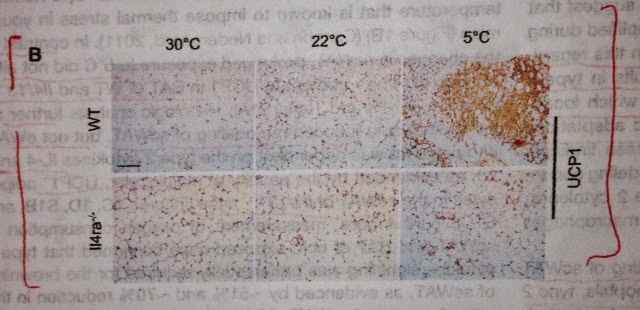Obesity develops when
there is an imbalance between energy intake and expenditure. A brown
adipose tissue (BAT) is a specialized adipose tissue involved in
thermogenesis and energy dissipation in response to cold.
This new study (1) published
in Cell indicates, that strangely, BAT response to cold is mediated
via cytokine IL-4.
The authors in this
study wanted to understand how type 2 immunity (Th2 response
dominated by IL-4 and IL-13) affects cold-induced brown fat
remodeling.
To this end, wild-type or IL-4 /IL-13 double KO mice were exposed to
thermoneutral (30C), sub-neutral (22C) and cold temperature (5C) and
subcutaneous white adipose tissue response were examined. Unlike
wild-type mice, IL-4 /IL-13 double KO mice did not show response to
cold.
Similarly, IL-4ra KO
mice did not show response to cold.
Examination of
subcutaneous white adipose tissue (scWAT) in STAT6 KO mice confirmed
that IL-4 signaling was crucial for thermogenic response to cold.
To understand what cell
type was producing IL-4, the authors examined 4get mouse that express
GFP protein from endogenous IL-4 locus. Expression pattern indicated
that IL-4 producers were eosinophils. Indeed, using 4get mice
deficient in eosinophils, the authors could abrogate cold response in
scWAT.
In addition, the authors
found that mice deficient for CCR2 also lacked scWAT response to
cold. CCR2 is required for recruitment of macrophages into tissue.
To authors speculated
that IL-4 driven macrophage-specific tyrosine hydroxylase (TH)
expression was responsible for scWAT response to cold. To test this
hypothesis, they have generated mice with specific deletion of
tyrosine hydroxylase in macrophages. Indeed, this TH f/f Lyz2-cre
mice lacked scWAT browning
response to cold.
Finally, to examine the
role of exogenous IL-4 on browning of scWAT, the authors injected
mice, fed with high-fat diet, with IL-4/anti-IL-4 complexes to mimic
efficient IL-4 signaling. Such treatment mimicked cold-response in
scWAT with corresponding body fat and mass reduction and increase in
insulin sensitivity.
In summary, the authors
showed that long-held idea that cold response is neuronal driven
response is outdated. It appears that type 2 immune response,
specifically, eosinophil-derived IL-4 stimulates local
macrophage-specific tyrosine hydroxylase activity and catecholamine
production leading to local browning of scWAT and thermogenic
response.
Of course, it is very
interesting to know how eosinophils are sensing cold or suboptimal
temperature. I think it will be a local commensial microbiota-induced
effect.
The idea that immune
system can sense a temperature gradient is quite surprising in
itself. Though almost everyone can affirm common observation that
when children or even adults happened to fall asleep in the couch,
others are trying to cover them with blanket to prevent them from
getting or catching a “cold”. Does such empirical observation
imply that cold-induced type 2 response has its undesirable effects?
David Usharauli





No comments:
Post a Comment